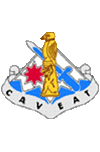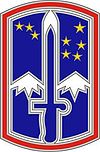

 |
The Lineage of 172nd Stryker Brigade |  |
The 172nd Stryker Brigade, now designated as the 172nd Stryker Brigade Combat Team, traces its history back to the 172nd Infantry Brigade first activated in 1917. Deployed to France and assigned to the 86th Infantry Division at Bordeaux during World War I. Tthe brigade was used to reinforce front-line units, therefore, its actions in France during that time are not completely clear because of its men being sent to different units throughout Fance. Due to the lack of information regarding its role during the war, the unit was awarded a WWI streamer without an inscription. The unit was demobilized after the war in January, 1919 and, in 1921 was sesurrected as Headquarters and Headquarters Company (HHC), 172nd Infantry Brigade and again assigned to the 86th. From 1922 through 1936, the brigade went through several redesignations; in December, 1942, becoming the 86th Calvary Reconnaissance Troop and, in August, 1943, being redesignated the 86th Reconnaissance Troop, Mechanized. The brigade remained in the U.S. until 1945. Arriving in France in March, 1945, the brigade was immediately moved to Koln, Germany to relieve the 8th Infantry's defensive positions around Weiden, Germany.
During its few months of combat duty in Europe, the troop participated in amphibious assaults across was Danube, Bigge, Altmuhl, Isar, Inn, Mittel-Isar and Salzach rivers in Germany and Austria. While in Europe, the unit was assigned to 1st, 3rd, 7th, and 15th US Armies and in May, 1945 was sent back stateside to prepare for rediployment in the Pacific Theater. They were shipped to the Philippines, arriving on September 7th, 1945, five days after the Japanese surrender. The brigade, now renamed the 86th Mechanized Reconnaissance Troop, was inactivate in December, 1946 only to be reactivated in July, 1952 as part of the Army Reserve and continuing as a reserve unit until 1963.
A reorganization within the army reintroduced brigades to the army structure and it began assigning three brigades to each division. This new structure allowed the assignment of "separate" brigades (brigades with no HHC) to be added into the mix. Once again, the 3rd Platoon, 86th Reconnaissance Troop, as it was again named, was relieved from the reserve assignment to the 86th division and renamed the 172nd Infantry Division. Surprise! The new structure of the brigade consisted of one "Light" Infantry Brigade, one mechanized infantry battalion, and one tank company. Weathering reorganizations in 1969, 1974 and 1978, deactivation of the unit came in April, 1986.
In the 1990's, all "separate" brigades were deactivated due to a down-sizing of the army following the end of the cold war. This resulted in several divisional brigades being stationed away from their HHC and support companies causing operational difficulties for the brigades. This situation caused the army to decide to activate the former "separate" brigades and assign them their own support units allowing them to function without a division level headquarters and be stationed where it was impractical to station an entire division (ie: Alaska and Europe). These new units were now referred to as "Brigade Combat Teams". The first to be reacitvated and reassigned in this new format was the 172nd Infantry Brigade. The 1st Brigade, 6th Infantry, stationed in Wainwright, Alaska, was reflagged[1] as the 172nd. In 2000, the brigade was given an air assault infantry battalion from the reactivated 173rd Airborne Brigade and 2 battalions from the 2nd Infantry Division. This new "theater defense brigade" would be available for deployment throughout the northern Pacific if needed.
In July, 2001, the "Brigade Combat Team" underwent another transformation being designated as a "Stryker Brigade Combat Team with the addition of approximately 300 new "Stryker" vehicles and several unmanned aerial devices. From 2001 through October, 2003 extensive training in tactics, vehicle maintenance, building facilities and various logistic changes were instigated to transform the unit to the "Stryker" plan. The training and fine tuning continued up to 2005 when the unit was informed it would be deployed for "Operation Iraqi Freedom" In August, 2005, the 172nd Stryker Brigade deployed to Mosul, Iraq, assuming patrol operations, searches and counter-insurgency operations. Prior to its 12 month tour ending in Julyl, 2006, the unit was expectedly extended until November, 2006 and send to Baghdad because of increased enemy activity. In "typical" army fashion, some of the brigades elements had already arrived back in Alaska and had to be flown back to staging areas in Iraq. Finally, after a 16 month stint in Iraq, the 172nd returned home having suffered 26 KIA and approximately 350 wounded. Also, there were 10 KIA's suffered with units attached to the brigade during its tour.
Upon its return, the 172nd Stryker Brigade Combat Team was officially inactivated and the 1st Stryker Brigade Combat Team, 25th Infantry Division was activated in its place on 14 December 2006. The brigade's six battalions and four separate companies were likewise reflagged as part of the change. The reflagged units were:
In December, 2007, the army announced it would activate and retain two Infantry Brigades in Germany until 2012 and 2013. March 6th, 2008, it was announced that the 172nd Infantry Brigade would be activated as the first of these brigades, with the other being the 170th Infantry Brigade. On March 17th, the 172nd Infantry Brigade was formally activated in Schweinfurt, Germany by reflagging the 2nd Brigade, 1st Infantry Division, which had recently completed a tour of duty in Iraq. The 172nd Infantry Brigade was activated with the following unit redesignations:
In May 2008, the brigade was alerted that it would be returning to Iraq in the fall with deployment set to last 12 months, starting after the unit's 12-month out-of-action cycle ended on November 2008. In fall of 2008, the brigade completed its transition to a brigade combat team, and was redesignated as the 172nd Infantry Brigade Combat Team and deployed to Iraq in December, 2008. for a 12 month tour. Upon redeployment from Iraq, the 172nd Stryker Brigade Combat Team was deactivated and reactivated as the 1st Stryker Brigade Combat Team, 25th Infantry Division (one unit still assigned is the 1st Battalion, 24th Infantry Regiment, formerly 2nd Battalion, 1st Infantry Regiment. In September 2008, 1st Stryker Brigade Combat Team, still based in Fort Wainwright, Alaska, was deployed to Iraq returning in September, 2009. The Department of Defense announced the 1st Stryker Brigade Combat Team, 25th Infantry, will head to Afghanistan for a one-year deployment beginning in May, 2011.
The 172nd has accumulated the following recognitions throughout its existence: World War I campaign streamer (no inscription 1918), World War II campaign streamer (Central Europe 1944–1945), Operation Iraqi Freedom campaign streamer (Iraq 2005–2006) and the Valorous Unit Award (2006) for service in Operation Iraqi Freedom.
[1] Reflagging in the army is an attempt to retain as much unit integrity as possible with regards to its organizations with the greatest heritage. With the down sizing of the army, starting with the end of the cold war, it is essential that our oldest and most honored organizations remain. As posts close and units inactivate, flags and colors move around to ensure their retention placing more emphasis on retaining units with the most history and honors. In combat, individual exploits and personal valor are important, but unit effort wins the battle; the Army pays close attention to unit performance, to the organizations in which its soldiers serve and fight, and to the flags and colors that symbolize those organizations.
| Return to History Page | Return to Home Page |